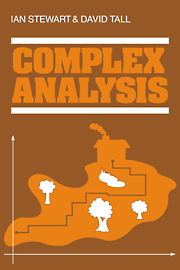Book contents
- Frontmatter
- Contents
- Preface
- Acknowledgement
- 0 The origins of complex analysis, and a modern viewpoint
- 1 Algebra of the complex plane
- 2 Topology of the complex plane
- 3 Power series
- 4 Differentiation
- 5 The exponential function
- 6 Integration
- 7 Angles, logarithms, and the winding number
- 8 Cauchy's Theorem
- 9 Homotopy versions of Cauchy's Theorem
- 10 Taylor series
- 11 Laurent series
- 12 Residues
- 13 Conformal transformations
- 14 Analytic continuation
- Index
2 - Topology of the complex plane
Published online by Cambridge University Press: 05 June 2012
- Frontmatter
- Contents
- Preface
- Acknowledgement
- 0 The origins of complex analysis, and a modern viewpoint
- 1 Algebra of the complex plane
- 2 Topology of the complex plane
- 3 Power series
- 4 Differentiation
- 5 The exponential function
- 6 Integration
- 7 Angles, logarithms, and the winding number
- 8 Cauchy's Theorem
- 9 Homotopy versions of Cauchy's Theorem
- 10 Taylor series
- 11 Laurent series
- 12 Residues
- 13 Conformal transformations
- 14 Analytic continuation
- Index
Summary
In this chapter we collect together all the basic topological ideas we require for our study of complex analysis. The list is not very demanding. Some items are needed to handle differentiation neatly, and some are needed for integration. Differentiation is naturally set against a background of limits and continuity and these are best dealt with on open sets. On the other hand, an integral from one complex number to another is computed along a specified path between them. A set within which any two points can be joined by a path is said to be connected. To be able to cope with both integration and differentiation in the simplest possible manner later on, we shall restrict our complex functions to those defined on open connected sets. Such a set is called a domain.
Domains can have exotic shapes and paths can wiggle around a great deal. To be able to appeal to geometric intuition without our imagination having to work overtime thinking about complications like this, we use a carefully conceived technical device called the Paving Lemma. We show in this lemma that a path in an open set (in particular in a domain) can be subdivided into a finite number of smaller pieces in such a way that each piece is contained in a disc within the open set (thus ‘paving’ the path with discs). (Fig. 2.1) Now a disc is geometrically very simple; for instance any two points in it can be joined by a straight line.
- Type
- Chapter
- Information
- Complex Analysis , pp. 22 - 47Publisher: Cambridge University PressPrint publication year: 1983



